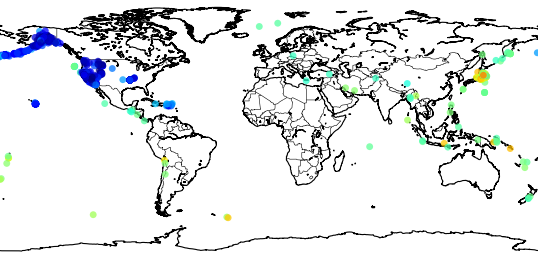I would like to share the video of the Eric Floehr (from ForecastWatch / Intellovations) presentation at PyCon 2011:
The aim of this post is to show to the reader how to plot the recent Japan earthquake data from the USGS using the pyearthquake module. If you want to know more information about the pyearthquake module, take a look in this post where I previously used it. pyearthquake is a pure-python module which exposes an API to retrieve data from the USGS site as well from the MODIS Rapid Response System (recently, they created a separate project to handle Japan daily images).
Installing pyearthquake
The first thing we need to do is to install the Python pyearthquake module, you can do it using easy_install from setuptools:
easy_install pyearthquake
The easy_install should automatically handle the required modules, but if you face problems (specially in Ubuntu with basemap, here is the version requirements: matplotlib >= 0.99.0, numpy >= 1.3.0, PIL >= 1.1.6 and basemap >= 0.99.4.
Retrieving USGS catalogs
USGS provides the follow catalog datasets:
M1+ Earthquakes (past hour) – M1+PAST_HOUR
This is the worldwide catalog with earthquake data from the past hour;
M1+ Earthquakes (past day) – M1+PAST_DAY
This is the worldwide catalog with earthquake data from the past day;
M1+ Earthquakes (past 7 days) – M1+PAST_7DAY
This is the worldwide catalog with earthquake data from the past 7 days;
This is how you retrieve any of these catalogs using pyearthquake:
>>> from pyearthquake import *
>>> catalog = usgs.retrieve_catalog("M1+PAST_7DAY")
>>> len(catalog)
1179
In that context, we have 1179 incidents with magnitude 1+ from the past 7 days.
Lets filter now only events with magnitude 6+, which represents the recent significant earthquakes:
>>> mag6_list = [event for event in catalog if float(event["Magnitude"]) >= 6.0] >>> len(mag6_list) 30
We have now 30 events with magnitude 6+ from the past 7 days, let’s print it:
>>> for row in mag6_list: ... print row["Eqid"], row["Magnitude"], row["Depth"], ... row["Datetime"], row["Depth"], row["Region"] ... c0001z5z 6.3 8.70 Friday, March 11, 2011 20:11:22 UTC 8.70 near the east coast of Honshu, Japan c0001z4n 6.6 10.00 Friday, March 11, 2011 19:46:49 UTC 10.00 near the west coast of Honshu, Japan c0001z2t 6.1 24.80 Friday, March 11, 2011 19:02:58 UTC 24.80 near the east coast of Honshu, Japan c0001z2a 6.2 10.00 Friday, March 11, 2011 18:59:15 UTC 10.00 near the west coast of Honshu, Japan c0001yib 6.2 18.90 Friday, March 11, 2011 15:13:14 UTC 18.90 near the east coast of Honshu, Japan c0001y4u 6.5 11.60 Friday, March 11, 2011 11:36:39 UTC 11.60 near the east coast of Honshu, Japan (...)
As you can see, almost all last events are earthquakes from the Japan coast. Here, you can extract any individual event and retrieve USGS products like ShakeMaps, etc (see more information in this post on how to fetch and show those USGS products).
Plotting events into the map
Now we will plot those events into the map (pyearthquake uses the matplotlib toolkit called basemap to plot events into the map):
>>> usgs.plot_events(catalog)
The “catalog” variable is the same we retrieved before using the USGS M1+PAST_7DAY catalog.
Here is what what this statement will show:
Now we can zoom into Japan using the button ![]() , and this is the result:
, and this is the result:
 The colored dots are the events from the retrieved catalog, the more strong the color the more strong was the earthquake; see the dark red color near the cost, that event was the unfortunate and catastrophic 8.9 magnitude earthquake which devastated Japan yesterday.
The colored dots are the events from the retrieved catalog, the more strong the color the more strong was the earthquake; see the dark red color near the cost, that event was the unfortunate and catastrophic 8.9 magnitude earthquake which devastated Japan yesterday.
Retrieving near real-time MODIS Rapid Response images
MODIS has processed image subsets of Aqua and Terra satellites. One of these subsets is called “japan” and it has the entire country coverage. Let’s retrieve this MODIS subset and then plot our events in this same map:
>>> import datetime >>> now = datetime.datetime.now() >>> bmap = modis.get_modis_subset(now, "Japan", satellite_name="terra", resolution="250m", show=False) >>> usgs.plot_events(catalog, bmap)
What pyearthquake is going to do here is to download (this may take some time) the entire subset for the resolution of 250m (the best available), parse the subset metadata, align image into the map between the lat/lng bounds and then plot the events over this satellite image, so we’ll have the last high resolution satellite images from the Japan together with the earthquake events plot, and here is the result:
And here is the zoom near the coast:
If you are going to PyCon US 2011, I would like to invite you to the talk “Genetic Programming in Python“, the talk will be given by Eric Floehr on March 12th 1:20 p.m. – 2:05 p.m.
Here is the abstract:
Did you know you can create and evolve programs that find solutions to problems? This talk walks through how to use Genetic Algorithms and Genetic Programming as tools to discover solutions to hard problems, when to use GA/GP, setting up the GA/GP environment, and interpreting the results. Using pyevolve, we’ll walk through a real-world implementation creating a GP that predicts the weather.
(…)
Genetic Algorithms (GA) and Genetic Programming (GP) are methods used to search for and optimize solutions in large solution spaces. GA/GP use concepts borrowed from natural evolution, such as mutation, cross-over, selection, population, and fitness to generate solutions to problems. If done well, these solutions will become better as the GA/GP runs.
GA/GP has been used in problem domains as diverse as scheduling, database index optimization, circuit board layout, mirror and lens design, game strategies, and robotic walking and swimming. They can also be a lot of fun, and have been used to evolve aesthetically pleasing artwork, melodies, and approximating pictures or paintings using polygons.
GA/GP is fun to play with because often-times an unexpected solution will be created that will give new insight or knowledge. It might also present a novel solution to a problem, one that a human may never generate. Solutions may also be inscrutable, and determining why a solution works is interesting in itself.
From R&D Mag – Developing a potential life-saving mathematical tool -:
Math and medicine are coming together to help people who have suffered an abdominal aortic aneurysm, which with 15,000 is the 13th-leading cause of death in the United States.
At the heart of the effort are genetic algorithms written by Oak Ridge National Laboratory researchers that allow physicians to more efficiently assess and organize the often vast amounts of information contained in patient reports. Ultimately, with this tool—a sophisticated way to quickly extract key phrases—doctors will be able to characterize features and findings in reports and provide better patient care.
(…)
This work builds on previous studies involving genetic algorithms developed for mammography. That system allows doctors to quickly identify trends specific to an individual patient and match images and text to a database of known cancerous and pre-cancerous conditions.
Read full article here.
Developing a potential life-saving mathematical tool
Sometime ago I discovered the project called Gource, which is a Software Version Control Visualization tool created by Andrew Caudwell. Gource has a very interesting visualization structure which isn’t exclusive to Version Control systems, but also for a large variety of data; actually, you can create your own custom log (see CustomLogFormat wiki for more details) in order to use Gource visualization for your own data.
So I have created a Python script which exports the data from your Google Analytics profile and then convert it to the custom Gource log format. To extract Google Analytics data I used the Google Data API bindings for Python, you also can make your own Google Data API query (see some samples here).
My query to Google Data was:
'ids': 'ga:[profile id]', 'start-date': '2011-01-19', 'end-date': '2011-02-02', 'dimensions': 'ga:pagePath,ga:date,ga:hour,ga:country', 'metrics': 'ga:visits', 'sort': 'ga:date,ga:hour', 'filters': 'ga:pagePath!@outbound;ga:pagePath!@translate;ga:pagePath!@search', 'max-results': '500'
See that I used some filters to avoid outbound links, Google Translate links from users as well the Search option. The profile I’ve used in this example is the Pyevolve Documentation site which has two main directories (a site with more directories should provide you better visualization, since Gource is specially good on viewing branches on Version Control Systems), I also have limited the size of the results to 500, so we can get a short video.
Instead of using unique users to represent users, I’ve used countries and I also changed the default user icon from Gource to world flags (by Vathanx, you can download them here).
And here is the result (see in HD – 720p):
You can download the source code here. See the comments inside the script to use with your Google Analytics Profile. In order to get flags working, you need to extract the flags to a directory and then run “gource custom_log.txt –user-image-dir [directory-with-the-pngs]“.
I hope you enjoy it =)
– Christian S. Perone
From The Economist article:
WHILE watching the finale of the Formula One grand-prix season on television last weekend, your correspondent could not help thinking how Darwinian motor racing has become. Each year, the FIA, the international motor sport’s governing body, sets new design rules in a bid to slow the cars down, so as to increase the amount of overtaking during a race—and thereby make the event more interesting to spectators and television viewers alike. The aim, of course, is to keep the admission and television fees rolling in. Over the course of a season, Formula One racing attracts a bigger audience around the world than any other sport.
Read the full article here.
Any text structure can be represented using Markov Chain states and transition probabilities, for the sake of simplicity I’ll not use probabilities to describe the state transitions, I’ll use only true or false, saying only that this transition is possible or not (100% or 0%).
A Markov Chain in this simple form can be formulated as a set of possible states, lets say as well a dictionary-like data structure in the form of
representing the possible transition states, but let’s put an example text on it to make it clear:
the white rabbit and the white fox
Then the possible states of this text are , and the dictionary structure should be:
These transition rules can be incrementally updated. Note that these rules represent the structure of the text and not the text by itself; when updated for instance, with a whole book, it captures the profile of the writer, the characteristics often used by the author, even more enforced when incrementally updated with more than one book of the same author.
I implemented a simple tool using Python and NLTK (just to parse and tokenize the text) that can be used to read an input text and incrementally update a Markov Chain data structure in a way to be reused later in order check similarity with another text.
The most interesting part of these chain is that they also offer a property present in Bloom Filters: false positives are possible but not false negatives. In terms of our implementation and formulation, that property means that if we update a chain with the text of two books from Lewis Carroll, there would be (and of course, is a very low probability) another author (that the chain was not trained with their books) who can have the same chain, creating in this way a false positive, because the same chain from Lewis Carroll books could have the same chain of another different book, but you should note that is almost impossible (actually this fact would be very strange, since the authors style and words used are required to be almost the same) to find books from different authors who share the same chain.
You should note that we can also compare different chains in order to measure similarity between two authors/book profiles. This comparison is done by searching a previous trained chain (with the same author books or not) for the entries of the current chain in order to match the same structure of the chains and then calculate a ratio between the matches found and the total rules of the chain we are checking.
But hey, that’s a lot of blah blah blah and nothing of code, let’s see it in practice. Here is the help of the implemented tool (I created a repository in GitHub if you’re interested in the source-code):
$ python -m pymarksim.markov --help pymarksim v.0.1 By Christian S. Perone <christian.perone@gmail.com> https://blog.christianperone.com Type --help parameter for help. Options: -h, --help show this help message and exit -d DUMP_FILE, --df=DUMP_FILE Pickle object file ex. pickle.db -i INPUT_TEXT, --input-text=INPUT_TEXT Input text -m MODE, --mode=MODE Mode of operation: train, check -c COMPRESS_LEVEL, --compress-level=COMPRESS_LEVEL The gzip compression level, default is 9 (max).
So let’s train a chain using the “Alice Adventure’s in Wonderland” book (alice_adventures.txt) from Lewis Carroll (took from the Project Gutenberg):
$ python -m pymarksim.markov -d lewis.db -i alice_adventures.txt -m train
pymarksim v.0.1
By Christian S. Perone <christian.perone@gmail.com>
https://blog.christianperone.com
Type --help parameter for help.
File lewis.db not found, creating a new one...
Updating...
Done !
Here the tool created the file lewis.db which is the chain in a Python dictionary structure (I’ve used the cPickle module to serialize it and gzip compression). Now let’s check how close is this chain from the original text book:
$ python -m pymarksim.markov -d lewis.db -i alice_adventures.txt -m check pymarksim v.0.1 By Christian S. Perone <christian.perone@gmail.com> https://blog.christianperone.com Type --help parameter for help. File lewis.db found, loading... Checking... Match 100.00 %
As you can see, we have a perfect match between the chain and the text book. Now comes the interesting part, let’s check an unrelated book with this chain trained with the Alice Adventure’s in Wonderland, for this, I took the book “The Adventures of Sherlock Holmes” (doyle.txt) from Sir Arthur Conan Doyle (also from the Project Gutenberg):
$ python -m pymarksim.markov -d lewis.db -i doyle.txt -m check pymarksim v.0.1 By Christian S. Perone <christian.perone@gmail.com> https://blog.christianperone.com Type --help parameter for help. File lewis.db found, loading... Checking... Match 7.14 %
See that now the match of the chain from Sherlock Holmes with the Alice Adventure’s is now 7.14%, remember that a perfect match is 100.00 % !
Let’s check now this chain trained only with the Alice Adventure’s in Wonderland of Lewis Carroll with another book from the same author, called “Through the looking-glass” (looking-glass.txt):
$ python -m pymarksim.markov -d lewis.db -i looking-glass.txt -m check pymarksim v.0.1 By Christian S. Perone <christian.perone@gmail.com> https://blog.christianperone.com Type --help parameter for help. File lewis.db found, loading... Checking... Match 25.93 %
See that now we have a match of 25.93% ! Let’s check with a more related book also from Lewis Carroll, called “Alice Adventure’s Under Ground” (underground.txt):
$ python -m pymarksim.markov -d lewis.db -i underground.txt -m check pymarksim v.0.1 By Christian S. Perone <christian.perone@gmail.com> https://blog.christianperone.com Type --help parameter for help. File lewis.db found, loading... Checking... Match 57.84 %
That’s very related don’t you think ?
I hope you liked it, Markov Chains are a very powerful way to capture system processes, and can be used in ways we usually do not expect.
“So many out-of-the-way things had happened lately, that Alice had begun to think that very few things indeed were really impossible.” – Alice Adventure’s in Wonderland
Eric Floehr (from Intellovations) kindly sent me the presentation he presented at PyOhio 2010. I think Eric has captured some nice features of Pyevolve which few people use, like DB Adapters, dot plotting, Interactive Mode, Real Time statistics, etc. He also presents an interesting use case where he uses Genetic Programming in order to forecast weather based on some historical data:
Thank you Eric !



 RSS Feeds
RSS Feeds Newsletters
Newsletters Bookmark
Bookmark
